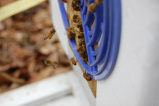|
The world is experiencing a rising trend in extreme weather events, including heat waves that pose significant challenges to various ecosystems. Honey bees, crucial pollinators that play a vital role in agriculture and natural ecosystems, are particularly vulnerable to these extreme heat conditions. When temperatures soar beyond their optimal range, honey bees must employ ingenious strategies to keep their hives cool and protect their developing brood.
Seabee Honey: Committed to Protecting Honey Bees At Seabee Honey, we are passionate about honey bees and their essential role in our world. We understand the impact of heat waves on honey bee colonies and are committed to supporting their resilience in the face of these challenges. We believe that understanding how honey bees adapt to heat waves is crucial for beekeepers and honey enthusiasts alike. Honey Bee Hive: A Delicate Balance of Temperature Honey bees thrive in a narrow temperature range, ideally between 32°C and 36°C (89.6°F and 96.8°F). This optimal temperature range is essential for the development of their brood, from eggs to larvae to pupae. Temperatures that fall outside this range can have detrimental effects on their survival and productivity. Excessive heat can disrupt the development of brood, weaken adult bees, and even lead to hive abandonment. Evaporative Cooling: The Bee's Natural Air Conditioner To combat the scorching heat, honey bees employ a remarkable evaporative cooling system that resembles a natural air conditioner. As temperatures rise, bees stationed at the hive entrance begin fanning their wings rapidly, creating a gentle air current that draws cooler air into the hive. This process, known as fanning, helps to circulate air and remove warm air from the hive. In addition to fanning, bees also collect water from nearby sources and distribute droplets throughout the hive. This water evaporates, absorbing heat from the surrounding air and effectively lowering the hive temperature. The process of evaporative cooling is particularly effective in dry environments, where the rate of evaporation is higher. Hive Placement and Ventilation: Strategies for Passive Cooling The strategic placement of hives plays a crucial role in maintaining a cool internal environment. Seabee Honey beekeepers often place hives in shaded areas, under trees or structures, to minimize direct sunlight exposure and reduce heat gain. Additionally, hives are designed with openings that allow for proper ventilation, enabling air to circulate freely and prevent heat buildup. Beekeeper's Role in Supporting Hive Cooling Seabee Honey beekeepers go the extra mile to support honey bees' efforts to cope with heat waves. We provide readily accessible water sources, placing shallow dishes or trays of water near the hives to encourage bees to collect water more efficiently. Additionally, we consider placing hives over moist ground or porous materials, as these can help maintain a cooler surrounding environment.
0 Comments
Leave a Reply. |
Details
SEABEE HONEY BLOGAuthorA beekeeper in New Hampshire [email protected] Archives
December 2023
Categories
All
|

 RSS Feed
RSS Feed